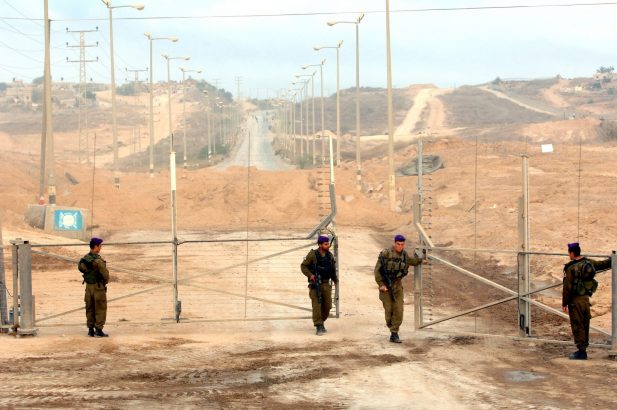Asher Susser believes that while the status quo is not sustainable, a final status agreement is currently unattainable: that is Israel’s dilemma. Because Israelis and Palestinians approach the negotiation table from ‘two different historic time zones’, there is no trust between the sides, meaning Israel should now take the unilateral option to keep the two state dynamic alive, along with its democratic character and the support of the international community.
The two-state imperative
Samuel Nurding: In your book ‘Israel, Jordan and Palestine: The Two-State Imperative’ you say the reason there has been no peace deal is because: ‘For the Israelis, the point of departure was the territories in 1967 … the Palestinian point of reference was 1948.’ Can you explain what the difference between these two frameworks is, and how has it affected both side’s approach to negotiations?
Asher Susser: The major issue is the difference between the Israeli-Palestinian negotiations and the inter-state negotiation. For Israel and neighbouring states, the only issue is the ‘1967 file’ – namely land and borders – so Israel has been able to make peace with Egypt and Jordan. With the Palestinians though, there is the 1967 file, as well as the 1948 file, which from the Palestinian point of view, relates to their very collective being, to the question ‘What is a Palestinian?’ It’s an identity issue. What differentiates a Sunni, Arabic-speaking man from Palestine from a Sunni Arabic-speaking man from Jordan or Egypt? The answer is collective memory. The Palestinians view the events of 1948 as a disaster, and that defines what Palestinian-ness is; the association with 1948, whether you were there or not, is handed down from generation to generation.
Two different historic time zones
The Israelis and the Palestinians are approaching the negotiation table from two different historic time zones. Israel wants to end the conflict on the basis of solving the West Bank/Gaza issue – the 1967 issues. For the Palestinians, however, the conflict did not begin in 1967, but in 1948. They feel the need to redress their grievances from this earlier period in order to establish a Palestinian state within the 1967 boundaries. The main issue of the 1948 file is the refugee question and if there is to be a solution to the conflict, there has to be some measure of satisfaction on that issue.
Because of the questions of identity and historical narrative arising from 1948, the Palestinians were, and remain, unable to separate themselves from 1948, as they develop negotiation demands. On the other hand, Israel wanted to have a trade-off: It was prepared to concede on just about all of the 1967 issues (land, borders, settlements, Jerusalem) but in exchange it wanted closure on the 1948 file, to which the Palestinian refused. Thus, both sides have a principled acceptance of the two-state idea but have very different perceptions of what two states actually means.
This cognitive dissonance has also intruded into the negotiations, particularly on the 1967 file. For example, after multiple rounds of negotiation, Israel agreed to concede over 90 per cent of the West Bank to the Palestinians; the Palestinian said it must be 100 per cent. Their reasoning: ‘You Israelis already possess 78 per cent of Mandatory Palestine (which we Palestinians already compromised on), and now you want us to compromise more over the 22 per cent (the West Bank and Gaza) that remains?’ The Israelis saw that reasoning as being very inflexible, all or nothing. This is a typical example of both sides coming into the negotiations from two very different historic time zones. The Palestinians count the percentage from 1948; the Israelis count the percentages from 1967.
There is another problem: neither side can fulfill their minimum goals without intruding into the other side’s existential domain. For example, the Palestinian state intrudes into Israel via the refugee question; and the Israelis intrude in a future Palestinian state with their security measures (which the Palestinians regard as eroding their sovereignty) – another stumbling block to negotiations.
SN: The ’48 file consists of two key issues: refugees and recognising Israel as a Jewish state. Why do Israelis regard the latter as a deal-breaker?
AS: The demand for the Palestinians to recognise Israel as the nation state of the Jewish people is to create a firewall between 1948 and 1967. At the beginning of peace negotiations, the Israelis spoke about the Palestinians agreeing to end the conflict. It was very important to have the Palestinians declare that once a state was established in the West Bank and Gaza, there would be no further claims to other parts of Historic Palestine that are now part of the State of Israel. Israel didn’t have this problem with Egypt or Jordan – it was very clear where those states ended and Israel began, and thus there was no such demand for them to declare an end to conflict. In the case of Palestine, it is not exactly clear where a future state would begin and end. Instead of demanding an end to conflict, the Israelis called for the Palestinians to recognise Israel as the nation state of the Jewish people, which in practice means refugees will return to Palestine and not Israel.
As I’ve said, the demand for the Palestinians to recognise Israel as the nation state of the Jewish people creates a firewall between 1948 and 1967. The problem, however, is that the Palestinians cannot recognise Israel as the nation state of the Jewish people, because if they do so, then they are recognising that historically Palestine is Jewish. So we’re still stuck in the same quandary without any resolution. Unlike the inter-state negotiations, which had a clear endgame, the endgame for the Israelis and Palestinians is not so.
Israel, not the Palestinians, has the support of the international community on the refugee issue because the international community makes a very clear distinction between the occupation (which began in 1967) and the creation of Israel in 1948. They do not challenge Israel’s creation. The Palestinians – because of the centrality of the refugee question – do.
SN: To what extent can the contrasting understandings of history held by the two sides – especially regarding 1948 and the War of Independence / the Nakba – be incorporated into a political framework of a two-state solution?
AS: The peace process is based on UN Security Council Resolution 242, which for over the first 20 years of its existence the Palestinians refused to accept. When the Palestinians did finally accept 242 in 1988, it was a conditional acceptance, based on that resolution being in conjunction with other UN resolutions related to Palestine, the key one of which is UN General Assembly Resolution 194. Although 194 does not unconditionally endorse refugee return, the Palestinians overwhelmingly interpret it as if it does. For them, 194 is the right of return. Israel is willing to negotiate 242 but not with 194 being included, whereas the Palestinians are not prepared to negotiate just on the basis of 242.
You might ask why an interim arrangement cannot be agreed; separate from a clear vision of the endgame. Well the Palestinians fear that for the Israelis, an interim agreement will be permanent. The Israelis fear that for the Palestinians, a permanent agreement will be interim. Therefore there is a lack of trust between the parties. An interim arrangement is very logical, but not workable in the current circumstances. How do you resolve the 1967 problem with the component of 1948, which for Israel does not relate to the occupation but to Israel’s very existence? Solve that question, and you solve the conflict.
Keeping the two-state dynamic alive
SN: If Israelis and Palestinians are in limbo, is the status quo sustainable? If not, what should be done to create conditions to change it?
AS: Israel has to ask itself what it should do if it cannot have a two-state solution based on negotiations. Many people in Israel, including the government, would argue that we should leave things as they are. But if we don’t do something to alter this status quo, we’re allowing ourselves to descend down a slippery slope to a one state reality, which would be contentious, conflictual, and more reminiscent of the former Yugoslavia. It would be disastrous for Jews.
An interim arrangement is one option that can be pursued in order to try and create a more conducive atmosphere for a two-state solution. An interim agreement says, ‘Let’s resolve what we can now, and leave what we can’t until later.’ The Palestinians though, are only likely to agree to an interim arrangement if consensus can be reached on what the endgame is, believing that Israel will ultimately not be willing to go beyond an interim arrangement. So then you have to sit down and negotiate the endgame again, which fails because neither side agrees to what that endgame is.
The word solution then, is too heavy a word to use in this context. I don’t think we’re going to arrive at a solution in the sense that Israelis and Palestinians agree on a satisfactory resolution to the conflict. But to thus conclude that there is nothing to be done is wrong, at least from Israel’s point of view, because the status quo is not static, and not in Israel’s long-term favour.
The status quo is not in Israel’s favour firstly, due to the demographic problem that results in Israel being in control, one way or another, over millions of Palestinians, which undermines the capacity of the state to maintain itself in the long-run as the nation state of the Jewish people. (And if Israel doesn’t maintain itself as the nation state of the Jewish people then, historically speaking, what is the point of Zionism?)
Second, there is the issue of Israel’s international legitimacy. The State of Israel’s international legitimacy is based on the 1947 UN Partition Plan. The international community views Israel as a just cause, but in the framework of partition. If Israel is perceived to be moving away from partition and the two-state idea, then its international legitimacy will be steadily undermined. If you look at the international criticism of Israel, it doesn’t focus on Israel’s creation in 1948, nor really on the refugee questions, but predominately on the occupation. And when people speak about not importing Israeli goods, or boycotting Israel, it’s predominately in reference to the occupation. I would argue that since 1967, international recognition of Israel’s legitimacy within the 1967 boundaries has been reinforced. The continuation of the occupation however, is opening up questions about the legitimacy of Israel’s policy, and that is a dangerous place to be, as moving from this point to questioning the legitimacy of Israel itself, is a very short step.
The Unilateral Option
All that being the case – an interim arrangement is not possible, a negotiated settlement is out of reach – Israel is left with the unilateral option. I believe this option is the only real possibility Israel can resort to. It’s not a solution to the conflict. Rather, it’s a risky alternative with unclear results. But I don’t agree with those who say Israel shouldn’t unilaterally withdraw from the West Bank because of the results of the Gaza Disengagement. Ariel Sharon, who led Israel’s disengagement, did so not because he believed the withdrawal would lead to peace. He assumed rockets being fired from Gaza would continue. Rather, I believe Sharon was motivated by the need to release Israel of the burden of ruling over 2 million Palestinians and he was willing to withdraw from the majority of the West Bank based on the same logic.
The Gaza disengagement was obviously not carried out in the best way possible. If Israel were to launch a unilateral initiative in the West Bank, it should be phased over five to ten years. Israel can begin by withdrawing from the isolated settlements that are not a part of settlement blocs, hopefully with their agreement and without having to resort to forcible evacuation. The army’s withdrawal from these areas will only occur in conjunction with the establishment of a stable security situation and should be done gradually. This would not constitute a two state solution but it would preserve the two-state dynamic. We are in a one-state dynamic right now and there are too many people concluding, ‘let it be’.
If we foster a two-state dynamic and Israel does gradually undo the footprint it has in the West Bank, then we will have a two-state reality. Again, not a two-state solution, but a two-state reality, after which both sides will be able to conclude an agreement, through the framework of negotiations between two ‘states’. The Palestinian state will already be there, (even though it may not yet be called that), but we would have a two-state reality and that would progress into something more stable and permanent akin to which Israel enjoys with other Arab states including Egypt and Jordan.
The opposite of withdrawal is annexation of Area C (comprising 60 per cent of the West Bank), which would leave the Palestinians with about 9-10 per cent of Historical Palestine. If there are approximately 6.5 million Jews and 6.5 million Palestinians in Historic Palestine and the Jews have 90 per cent, I do not think there are going to be too many people who think that is a just division.





































I wonder if the author could clarify the passages regarding the the fraction of the original Mandatory Palestine that is now part of Israel. I had thought that the original mandate included Transjordan, which comprised 75% of the land. The creation of the Arab state of Jordan greatly reduced the area. Hence, Israel not including the West Bank and Gaza, covers less than 20% of the original Mandatory Palestine.